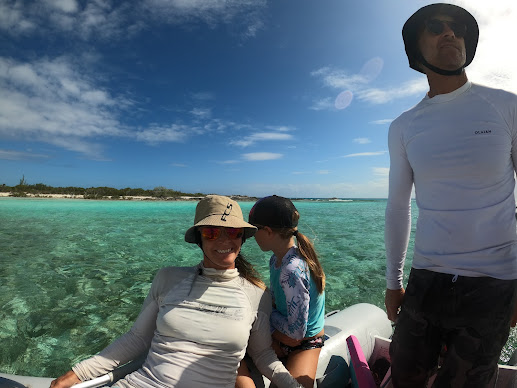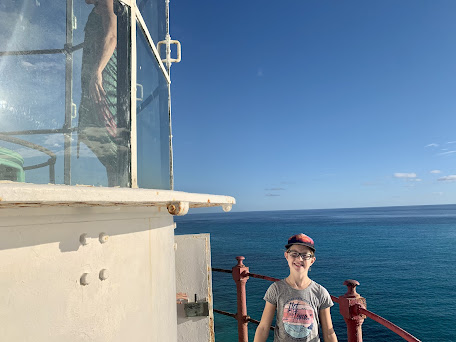We have had to make quick miles northwestwards because we have a lot of ground to cover. We want to spend at least a month in the Bahamas, so we brushed the surface of both Puerto Rico and the Dominican Republic. That involved some beautiful downwind sailing, and a couple overnight passages.
We stopped in San Juan, Puerto Rico. It has a rich history of Spanish settlement, fortification and has a very European feel to it. We anchored in San Juan’s big natural harbour. The harbour was the main reason this place was a perfect transfer point for all of the plundered riches of Central & South America (on their way to Europe in the 1500’s & beyond). The Spanish-American War in the late 1800’s saw the US take over control of this island. We were now back into the world of Walmart and cheeseburgers!
Right next to our anchorage was an “urban park” with 100 foot wide, overhead screens and fake grass. It was very surreal.
The old fort had an amazing setting looking out over the Atlantic Ocean with cemetery in the foreground. This tells the tale of a long history of European occupation.
The fortress was very impressive and was built in the 16th & 17th centuries. It was mainly used to defend attacks from rival European fleets and later from pirate attacks. It had massive walls that eventually included a large part of the old town.
Old Town San Juan was very cool with centuries of history and various eras of architecture. Touted as the “oldest city in the USA”, if feels very European because it was part of Spain until about 150 years ago.
Many of the streets were beautifully decorated and the atmosphere was very festive. Generally, San Juan felt very safe, clean and friendly. We took the opportunity to re-provision the boat, take the girls to a modern mall, and be proper tourists, in general. It was a nice urban stop and our only landfall on Puerto Rico.
There was a small park where we could feed the local pigeons. They were very used to people and quite aggressive at times. It was fun!
San Juan has many feral cats which are well looked after by the locals. Micah stopped to visit all of the cats that would let her pet them.
Next, we spent 48 hours on passage and landed in the Dominican Republic. Luperon is a favourite with cruisers for its protected anchorage, friendly people and cheap prices. It did not disappoint, and had all of those things in spades. During our trip here, Stu almost amputated his right big toe by dropping a heavy hatch cover on it! Luckily, it ended up just being badly bruised and he hobbled around for a few days while healing.
The check in procedure was very extensive, but friendly. The naval officer who inspected our boat (Richard) had a father-in-law that had horses - Micah’s dream! So we arranged some horseback riding through him. It all felt so welcoming and quaint. Richard gave the crew a ride to the ranch on his motorcycle.
The surrounding landscape was very dry and interesting at this time of year. The horses were great and the hosts were super friendly.
The trails were right above the anchorage and you could get views down to the ocean all the time.
Some of the trails would wind through surreal landscapes that looked like something out of “The Lord of the Rings”.
The DR is very into baseball and softball. We watched a game one evening and were impressed by how skilled the players were.
On our last day in Luperon we made friends with a family who had a Chihuahua puppy named “Dumbo”. He was the cutest little thing we had seen in a long time. He weighed about one pound and was very cuddly.
After leaving Luperon, we sailed north to the Bahamas and checked in at Great Inagua Island. The Bahamas cover a huge area, so we will keep moving north towards Nassau every few days.
We reunited with our Québécois friends aboard “Jayana” here and met some new friends aboard “Nahla”. With them, we did a back-of-truck tour of Great Inagua Island. It’s known for salt production, flamingoes and a huge lighthouse.
There were mountains of salt as far as the eye could see! It is harvested from evaporated sea water that sits in the enormous natural pools near the shoreline.
The wild flamingo population is thriving here and was rehabilitated by naturalists many years ago.
We also visited an old decommissioned lighthouse that was about 100 years old. All of these islands are extremely low-lying and were very difficult to see in years past prior to modern GPS navigation. Before the lighthouses were built, shipwrecks were a regular occurrence around the Bahamas.
Climbing the spiral staircase inside the lighthouse was a dizzying experience. It was about 150 feet tall!
We will continue northwards in the Bahama Island Chain. With its stunning azure-coloured water and its endless number of protected anchorages, we really think we’re going to love it here in the Bahamas. We will take our time and explore this water world before heading to Nassau by mid May. There, we will wait for a suitable weather window to make it up the Chesapeake Bay by early June.


































